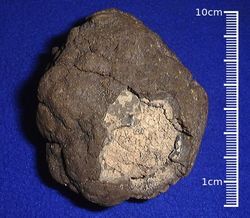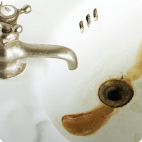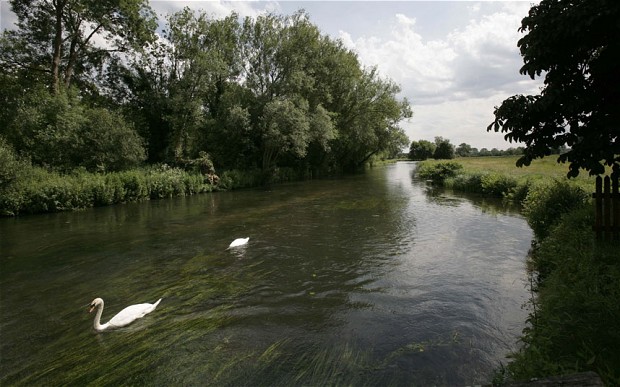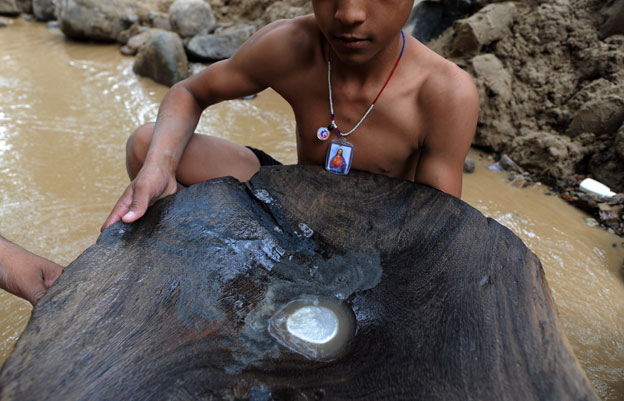We suggest that you read this issue on the Pure Water Gazette website. Just click here.
The Pure Water Occasional for December 2, 2013
In this issue you'll hear how cleaning products are ruining Great Britain's best fishing streams, how to prevent plumbing cross connections in your home, and how to get manganese out of well water. And as always, the best in of the week's world water news.
Home of British fishing ‘being destroyed by chemicals in cleaning products’
by Hayley Dixon
The River Test. The Rivers Test and Itchen, famous for their fly fishing, have been found to contain dangerous levels of phosphorus.
The home of British fishing is under threat of destruction from chemicals found in dishwasher tablets, experts have warned.
Chalk streams which feed into the rivers Test and Itchen have been found to contain alarmingly high levels of phosphorus.
The element can act as a fertiliser, accelerating the growth of weeds and murkying the clear waters which flow through Hampshire.
Environmental groups blame domestic cleaning products, particularly dishwasher tablets.
The two rivers – both classified as Sites of Special Scientific Interest and famous for their high quality fly fishing – are regarded as the finest chalk streams in the world.
Their waters support a rich diversity of mammal, bird, fish, invertebrate and plant communities, including trout, chubb, tench, grayling and bream.
The Test – which has even attracted former US President George Bush Snr to its banks – is known as the “Mecca” of the sport and is thought to have been popular since the 1880s.
The Environment Agency said the Itchen failed a recent chemical quality test, and officials expect it to fail again in 2015. This now puts the river in the “at risk” category.
The issue was discussed at the Chalk Stream Headwaters Forum, in Winchester, Hants, this week.
Dr Steve Rothwell, from the Vitacress Conservation Trust, said: “The UK is unusual in Europe because many EU countries long ago banned detergent products with phosphorus and the UK never has.
“In Hampshire phosphorus is a big problem. You get too much algae growing in the rivers as a result and it starts to out-compete the other plants you want.
“We know septic tanks are a problem. The chalk streams are so clear because they lack phosphorus, but if you add any it’s like adding fertiliser and you get all this growth.”
Birmingham University academic Alex Poynter, who has researched the issue for Hampshire and Isle of Wight Wildlife Trust, said the number of cleaning products in the UK containing phosphorus is “quite scary”.
The problem is made worse in rural areas because many homes use private drainage, and pollutants can find their way into rivers from septic tanks.
Agricultural run-off, with fertilisers washed off the land and into rivers, also contributes to elevated phosphate.
Graham Roberts, from the Hampshire and Isle of Wight Wildlife Trust, called the condition of the Itchen “disgusting”.
He said: “No water should be discharged with a quality worse than when it was abstracted. This is not an unreasonable aim to have.
“This is a real menace and changing the whole ecology of the river. It’s not rocket science, and needs to be sorted.
“I have had 27 phone calls and over 109 emails recently, particularly pertinent to the River Itchen.”
There are 161 chalk streams in Britain – 95 per cent of the world’s total – and most are located in the south-east of England.
An article on the fishing website fishpal.com describes the Test and Itchen as “stunning”.
It says: “Both rivers are stunning and hold any number of opportunities for visiting fishermen for most of the year, keen to enjoy the experience of challenging, exciting fishing on gin clear streams.”
The 39-mile-long river Test rises from the Upper Chalk near the village of Ashe, drains 480 square miles, and average annual rainfall of 32 inches.
Water quality in its upper reaches is so good that it is used for washing and processing paper used in the production of British banknotes.
The 28-mile-long Itchen rises from the upper chalk near New Cheriton, has a catchment area of 280 square miles, and an average rainfall of 34 inches.
Source: The Telegraph
Pure Water Gazette Fair Use Statement
How to control cross connections in your home
Editor’s Note: The following is sidebar information from a longer article that appeared in Coloradoan.com detailing the dangers of plumbing cross connections.
According to the article:
. . .30 percent of water providers inspected by the state since 2009 were found to be in violation for something related to cross connections or backflow — most often issues related to documenting or managing risks. And 9 percent of the water systems were found to have potentially hazardous cross connections.
Among schools operating their own small water systems, inspectors found cross connection issues to be even more prevalent. Roughly 47 percent were found to be in some kind of violation of cross connection or backflow rules, while risky cross connections were found in 19 percent of the schools, according to a recent analysis by the Colorado Department of Public Health and Environment.
If left unchecked, these routine plumbing problems can make people sick. Last fall, 26 people at a medical facility in Colorado Springs fell ill after drinking water that tasted and smelled odd. –Hardly Waite.
A few simple steps can help protect your drinking water from contamination via backflow in your home. Hiring a backflow prevention technician or a licensed plumber is the best way to make sure your plumbing is safe.
Faucets
• Make sure the lower end of each faucet is at least an inch above the top edge of the sink or tub.
Toilets
• Lift the top of your toilet tank and look inside. Make sure the fill valve is at least an inch above the water. • The bowl refill tube also should be above the water line.
Boilers
• Install a backflow preventer on your boiler. Otherwise, pressure from the boiler water — which is often treated with hazardous anti-corrosion chemicals — may be pushed into the potable water line.
Garden hoses
• Install a vacuum breaker on each outside spigot. • Never leave a hose submerged in a bucket, hot tub or swimming pool. Contaminants from the yard can be sucked back into your drinking water. • If you’re using a Miracle-Gro nozzle or other add-on to your hose, unscrew it when you’re done using it. Without a backflow preventer in place, fertilizer or other chemicals can contaminate your water.
Sprinklers
• Install a vacuum breaker well above the ground and above the level of all sprinkler heads in your yard to ensure that chemicals, fertilizer or pet waste aren’t pulled into your drinking water.
Source: Coloradoan.com.
Top Water Stories of the Week
Arab world sinks deeper into water crisis, warns UNDP. The Arab world is widely perceived as blessed with an embarrassment of riches: an abundance of oil, one of the world’s highest per capita incomes and the world’s tallest luxury building. But it lacks one of the most finite resources necessary for human survival: water.
Dandruff shampoo could mess up waterways. Toxicity testing on shampoo that fights flakes reveals that it's bad for plants and animals once it's in wastewater.
California water woes hit hard in driest year on record. The driest year on record has left California reservoirs so depleted - and the Sacramento-San Joaquin Delta so fragile - that state water officials say they may be able to provide just 5 percent of the water they and others were expecting for next year.
Millions upon millions of red crabs on Australia's Christmas Island are shutting down roads, covering beaches and stopping people in their tracks. They're on their way to the Indian Ocean.
How air and water pollution plague Indian cities. Outdoor air pollution caused over half a million premature deaths in India in 2010 – a huge jump from the 100,000 deaths estimated in 2000. And former rivers are now industrial drains, making tap water unfit for drinking. Living near one such drain is associated with chronic stomach disorders, hepatitis A and cancers of the bladder, kidneys, lung, skin, colon and liver.
California governor followed to events, heckled by environmentalists over fracking. Environmentalists frustrated with Gov. Jerry Brown’s permissiveness of hydraulic fracturing have followed him to events throughout California, heckling him for his approval of legislation establishing a permitting system for the controversial form of oil extraction.
New findings on PFOA and cancer in a highly exposed community. A major epidemiological study reports an association between perfluorooctanoic acid (PFOA) exposure and kidney and testicular cancers in people who lived near and worked at a plant that produced the chemical.PFOA is also a water contamination issue, and 98% of Americans have PFOA in their blood.
Mercury: A beautiful but poisonous metal. Mercury is the quixotic bad boy of the periodic table - exquisitely beautiful, but deadly. The ancients believed it was the "first matter" from which all other metals were formed. Yet it is now in such disfavor that an international treaty exists to curb its use.
Researchers say Arctic Ocean leaking methane at an alarming rate. Ounce for ounce, methane has an effect on global warming more than 30 times more potent than carbon dioxide, and it's leaking from the Arctic Ocean at an alarming rate, according to new research by scientists at the University of Alaska Fairbanks.
Member of Parliament demands EU action against Spanish pollution. Ashley Fox, Conservative MEP for Gibraltar and South West England, tabled the question before the European Parliament last week demanding that an end be brought to the persistent pollution of Gibraltar’s waters.
Water-borne diseases stalk Harare. Studies have shown that Harare water is contaminated with impurities, including urine. Some say Harare citizens are actually drinking purified urine, a serious indictment on the current government record. And children under the age of five are paying a heavy price for this. use shared toilets or pit latrines – while 6 percent have no toilets at all. Their trash may be getting picked up by youth groups, but only to be dumped in the river or on the road. Now, the Spatial Collective social enterprise is hoping to fix that.
Used cooking oil doesn't have to go to waste. The sight of a juicy, deep-fried turkey might set mouths watering on Thanksgiving, but a local environmental group is more interested in the slick, smelly bucket of grease it leaves behind.
Study: South Florida pollutants increase coral reef disease. Common South Florida pollutants are leading to a rapid increase in coral disease among South Florida coral reefs,
Sea turtle said to suffer virus caused by humans. A sick green sea turtle caught off the coast of Panacea last week has quickly become the focus of marine specialists and surgeons rushing to save the critter’s life from a virus said to be the result of human pollution.
Australian waters polluted by harmful tiny plastics. Each square kilometre of Australian sea surface water is contaminated by around 4,000 pieces of tiny plastics, according to our study. These small plastic fragments, mostly less than 5mm across, are loaded with pollutants that can negatively affect several marine species. T
Whitefish in Wisconsin rivers may indicate better water quality. The venerable Lake Michigan whitefish — a favorite of ice anglers and commercial fishermen — is turning up on inland waters where it hasn't been seen in a century. The fish have been found in at least four rivers in northeast Wisconsin, possibly due to improving water quality.
The US Department of the Interior has flooded the Grand Canyon in order to restore it.
Captain Mark Quartiano, a charter boat operator, caught an 800-pound sea creature that looks like it is straight out of the Mesozoic Era. See a picture of the 800 pound hookskate shark is rarely seen, but you can see a good picture on Huffpost.
Manganese
by Gene Franks
Manganese is a naturally occurring mineral that is present in soils, rocks, and sediment. It is a beneficial mineral found abundantly in many common grains and vegetables. It is essential to human nutrition, but in water it is generally regarded as unhealthy for humans in concentrations of as little as 0.5 parts per million.
In deep water wells, manganese can be found in concentrations as high as 2 to 3 parts per million, although amounts are usually smaller. As little as 0.05 parts per million (ppm) can cause black and brown staining. Manganese often exists with iron, and the two together often make chocolate-colored brown stains.

In general, manganese is difficult to remove from water because removal depends on its state of oxidation, the pH of the water, the presence of other minerals, and the TDS (total dissolved solids) of the water being treated. Another complication is that manganese often appears along with iron and hydrogen sulfide.
Evidence of manganese is often first seen in dishwashers because detergents raise the pH of the water high enough (>8) to allow manganese to precipitate (come out of solution and take on a solid, visible form). Another place to look for manganese is in toilet tanks, where it often appears as a floating film on the surface of the water. Shining a flashlight on the surface of the water makes the manganese film more obvious.

Forms of Manganese
Like iron, manganese in water takes on two forms.
The first and the most common is technically called manganous manganese. In this state the manganese is completely dissolved in the same way that sugar or salt are dissolved in water. To be removed with a filter, manganous manganese must first be “precipitated.” It can, however, be removed by a water softeneronly in this form.
After precipitation, manganous manganese becomes a solid and no longer remains in solution. It can turn water black. This form is called manganicmanganese. Precipitated manganese is easily removed by a filter, but it is not removed well by a water softener.
It is important to understand that a water softener is an ion exchanger. It deals with UN-precipitated ions. Filters can’t remove manganese or iron in their un-precipitated state. Softeners can serve as filters for precipitated manganese, but they are poor filters at best.
Removing Manganese from Water
The water treatment for manganese is similar to that for iron although there are some important differences, mainly involving pH. Removing manganese with a filter requires a higher pH than iron. Removing manganese with a filter is often easier if iron is present.
Removing Manganese with a Water Softener
If conditions are right, a water softener is the best tool for removing manganese. The softener can handle significant quantities of manganese, but it only works well if all the manganese is un-precipitated and remains un-precipitated. Precipitated manganese is not only poorly removed by the softener, but it is especially harmful to the softener resin.
Here are the conditions that most affect a softener’s performance as a treatment for manganese:
TDS: Softeners remove manganese best if the total dissolved solids (TDS) of the water is low. When TDS is high, other minerals in the water compete with the manganese for space on the resin and can even displace manganese which has attached to the resin. Water with <500 ppm TDS works best for manganese removal by a water softener.
Dissolved Oxygen: Water with a low dissolved oxygen level lends itself best to manganese reduction by ion exchange. This is true simply because high oxygen levels promote precipitation of manganese to a physical form that is hard for the softener to handle. The opposite, as we shall see, is true if manganese is being treated with a filter. [This applies as well to the presence of oxidizers other than oxygen. To remove manganese with a softener, the water should not be chlorinated or treated with other oxidizers like ozone, hydrogen peroxide, or potassium permanganate.]
pH: There are mixed recommendations from experts on this topic, but logically pH needs to be lower than 8 if a softener is to remove manganese as an ion. The pH must be low to prevent precipitation which occurs at higher pH levels. This is also contrary to what is needed for manganese removal with a filter.
As is also true with iron, when treating manganese with a water softener it is best to use a high salt dosage and keep service run short to avoid mineral build-up on the resin. Frequent regeneration is important.
Removing Manganese with a Filter
To remove manganese from water with a filter, a high pH reading and a sufficient oxygen content are necessary to insure precipitation. Although different filter media have different requirements, in most cases a pH greater than 8 is need for effective manganese removal. In most cases, an oxidizer like chlorine, air, ozone, or potassium permanganate is used as a pretreatment to filtration. Amendment of pH is also often needed.
Removal of manganese with a filter can vary from very simple, with any good granular medium, to a much more complicated two or three step process which requires adding an oxidizer and a pH amendment step.
Simple Filter
Manganic manganese can be easily removed by a simple filter. If the amount is very small, a cartridge-style sediment filter will serve. If a significant amount of manganese is involved, a backwashing filter containing multi-media (sand, garnet, anthracite, for example), Filter Ag, ChemSorb, Micro Z, or any good sediment reduction medium can be used.
Catalytic Media
In cases where un-precipitated manganese is present in a relatively low concentration and the oxygen content and the pH of the water are reasonably high, manganese can be handily removed with filter media that serve as catalysts to change the manganese to its precipitated form. Media such as Birm, Filox, and Catalox will cause the manganese to convert to its physical form then filter out the precipitated manganese in the same operation. Backwashing the filter then rinses away the trapped contaminant and restores the filter bed. Filters of this type are very effective if conditions are right, and they seem to work best if there is more iron in the water than manganese. Catalytic media filters can also be used after pretreatment with an oxidizer, as described below.
Pretreatment/Oxidation Filters
Pretreatment usually means a free-standing oxidizer, but it can also include pH enhancement.
Aeration
Pretreatment with air can be done in a number of ways. The oldest is with a “venturi” setup that is installed before the well’s pressure tank to draw air into the water line. The venturi is usually followed by a small vent tank that gives the air time to oxidize the manganese and to get rid of excess air. The water then goes to the filter, where the manganese is removed. A more aggressive and more effective system uses a larger treatment tank into which air is fed from a small air compressor. Air is compressed into the top third of the tank and oxidation occurs quickly as the water being treated falls through the pocket of compressed air. The filter follows the aeration tank. A variation on the compressed air system does the aeration in the filter tank itself, using, again, the top third of the tank and relying on an air draw feature supplied by the filter’s control valve rather than a compressor.
![aeriation-tanks[1]](https://ymlp.com/https.php?id=www.purewatergazette.net/blog/wp-content/uploads/2013/01/aeriation-tanks1.gif)
Closed Tank Aeration System that is fed by a small compressor. The top third of the tank holds a pocket of compressed air. Air is a powerful and reasonably rapid oxidizer. Aeration, of course, assures that the dissolved oxygen required for manganese removal is present, but pH is still a concern. A calcite tank can be added before the filter, but with the high pH requirement of manganese, soda ash or caustic soda injection usually works better.
When the water is properly pretreated with air and a pH enhancer, any good filter medium will remove manganese. Best results are gained, however, by using a top grade iron medium like Filox.
Chlorination
Chlorine is a strong oxidizer, but it requires more “residence time” than air. Chlorination can be done via a pellet dropper (dry pellet chlorinator), which drops calcium hypochlorite pellets into the well itself, or with a feed pump which inject liquid chlorine under pressure into the water line. If the pump is used, a retention tank must be added to give chlorine time to do its work. At least 20 minutes residence time is usually recommended.
As with aeration, the chlorination step must be followed by an iron filter. The choice again is wide, but one of the standard filters that works well independently or following aeration, Birm, cannot be used with chlorine. Carbon works well if the amount of manganese is small, and catalytic carbon works better than standard carbon. Carbon has the advantage of removing the chlorine along with the manganese.
When chlorine is fed by a pump, a pH increaser like soda ash can be injected along with the chlorine.
Potassium Permanganate
Potassium permanganate, a strong oxidizer, is used almost exclusively with filters using greensand as a medium. It is usually drawn into the filter during its regeneration stage. Greensand filters are effective removers of manganese, iron, and odors, but they are generally more difficult to maintain and are, therefore, not a favorite with owners of residential wells.
Ozone and hydrogen peroxide are also powerful oxidizers of manganese, but since they are seldom used in residential treatment, they aren’t being considered here.
More information about products that remove manganese:
Filox Filters (for iron, manganese, and hydrogen sulfide reduction).
Aeration Systems for Iron & Sulfide
Chlorine and Chemical Feed Systems
Please visit our RO Parts Page for tanks and accessories.
Thank you for reading. Please come back next week.
Places to Visit on Our Websites in the meantime
Model 77: “The World’s Greatest $77 Water Filter”
”Sprite Shower Filters: You’ll Sing Better!”
An Alphabetical Index to Water Treatment Products
Our famous whole house Chloramine Catcher
Pure Water Occasional Archive: Sept. 2009-April 2013.
Write to the Gazette or the Occasional: pwp@purewaterproducts.com
Please Visit
The Pure Water Gazette – now in an easier to navigate format.
![occasionalbanner300[1]](https://ymlp.com/https.php?id=purewatergazette.net/blog/wp-content/uploads/2013/04/occasionalbanner3001.gif)




